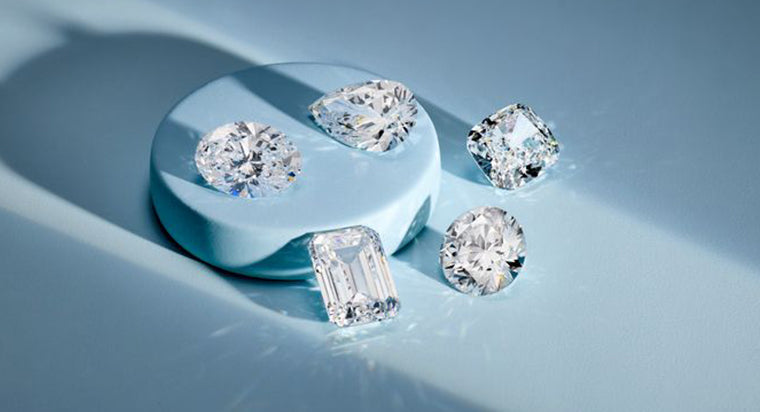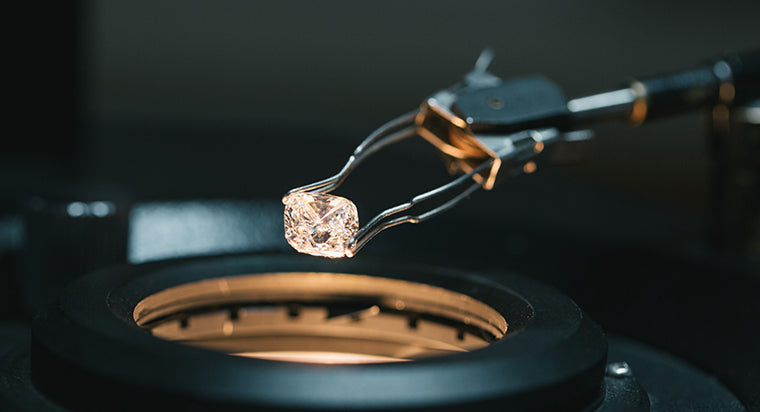Estimating a Diamond and Diamond Ring's Value

We get asked a lot of estimating diamond value is possible. The short answer is yes. A diamond's value is determined by its famous 4Cs: carat weight, color, cut, clarity. A value of a diamond is determined by an appraiser using these four dimensions while the value of a diamond ring adds the additional element of the quality of the band.
A diamond's carat weight is easily determined by the diamond's mass, as expressed in carats. One carat is equal to 200 mg. Although the determining carat weight is straightforward, carats' effect on value is a bit more complex. The value of a diamond increases exponentially with diamond carat because bigger diamonds are rarer. For example, if all other factors are the same (color, cut, clarity), a 2 carat diamond will be more than double the value of a 1 carat diamond. Thus, the diamond value per carat increases as the total carat weight increases.
TABLE OF CONTENTS
Diamond Ring Value
While diamonds are graded on carat, cut, color, and clarity, the value of a diamond ring also includes the ring itself. For example, a 14k gold ring with diamonds value would incorporate the value of the 14k gold band because the value of a ring is correlated to the market price of its metals. A diamond value estimator will consider the type and purity of the metal.
Additional diamond ring value factors include the ring's setting, design, brand, and condition. For example, more complex diamond ring settings may have a higher value because they are difficult to create. Similarly, popular designs or brands will have a higher value because they are in style, and thus desired. In addition, any wear and tear, such as worn-out prongs or bent parts, will negatively impact the ring's value.
Diamond Ring Value: Certification
A ring's appraised value is typically based on the market value of the piece. In other words, the appraisal value indicates how much it would cost to buy a new ring with similar characteristics. When looking to sell or insure your diamond, a qualified, independent diamond appraiser can determine the value of diamonds. And moreover, provide you with documentation useful in reselling or insuring your diamonds. Qualified diamond appraisers will have certification from respected organizations such as the National Association of Jewelry Appraisers (NAJA), the American Society of Appraisers (ASA), or the International Society of Appraisers (ISA).
Estimating the value of your diamond is a delicate and complex process that is best left to trusted, certified diamond appraisal veterans. Take the time to research the best diamond appraisers when looking to estimate the value of diamonds. For any appraisal-related questions: Contact us by phone at 1(844)-234-6463 or email at service@withclarity.com. Our Live Chat is available during business hours Monday - Friday, 10 AM - 5:30 PM ET.
Natural Diamond Price Chart
| Diamond Carat Weight | Total Price |
|---|---|
| 0.50 ct | $610 |
| 1.0 ct | $2,500 |
| 1.50 ct | $4,400 |
| 2.0 ct | $8,400 |
| 3.0 ct | $21,600 |
| 4.0 ct | $33,600 |
| 5.0 ct | $48,000 |
Lab Diamond Price Chart
| Diamond Carat Weight | Total Price |
|---|---|
| 0.50 ct | $300 |
| 1.0 ct | $1,300 |
| 1.50 ct | $2,000 |
| 2.0 ct | $4,240 |
| 3.0 ct | $12,840 |
| 4.0 ct | $24,048 |
| 5.0 ct | $35,028 |
How Diamond Value Determined?
The other factors of a diamond's value - color, cut, and clarity - can be graded on an established grading system such as that determined by the Gemological Institute of America (GIA) or the International Gemological Institute (IGI). Traditional colorless diamonds are graded on their lack of color, with the most colorless diamonds regarded as the most valuable. The stronger the yellow tint of a diamond, the lower its value.
While the traditional diamond is graded on its lack of color, fancy color diamonds are graded differently, with a grading system more closer in style to that used with colored gemstones. In addition, the value of fancy color diamonds is also more strongly affected by demand, which can fluctuate with trends, celebrity publicity, and time.
Black Diamond and Brown Diamond Value
For example, a black diamond's value changes depending on whether it is natural or treated. But estimating the diamond value for black stones needs to factor in its increased popularity in fashion. Brown diamonds, commonly marketed as chocolate diamonds, have many different value factors as well. The impact color has on a chocolate diamond’s value is based largely on the strength of the color, with stronger, darker chocolate diamonds being more valuable. In addition, the secondary color is crucial for chocolate diamond value. The rarer its secondary color, the higher the chocolate diamond's value.

Diamond cut is determined by the proportions of a stone and its proximity to the benchmark for an ideally cut diamond, with each diamond shape having a different ideal cut. The benchmark for ideal is the cut which maximizes the diamond's brilliance and sparkle. However, it is to be noted that some diamond shapes have a higher value than others.
Diamond clarity looks for the appearance of inclusions, or natural flaws, on the diamond and grades the diamond against a clarity scale. Diamonds with fewer inclusions visible under 10x magnification have a higher value while diamonds with inclusions visible to the naked eye have the lowest value.









